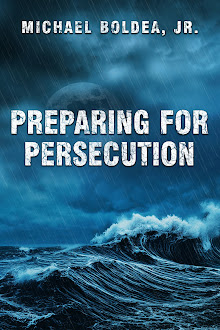We have come to the halfway point of our series, having already discussed repentance from dead works, faith toward God, and having begun, if only ever so briefly the discussion of the doctrine of baptisms. Since during the last program we discussed the baptism of John, today we will be continuing in our exploration of the doctrine of baptisms, and discuss what has come to be known today as water baptism, or the baptism into Christ for the remission of sins. Yes, the baptism of John differs from the baptism of Christ for the remission of sins, for while the baptism of John was only one of repentance, the baptism of Christ encapsulates both the baptism of John, which is the baptism of repentance, but adds to it, and completes it, including also the remission of sins.
Since both the baptism of John and the baptism of Christ for the remission of sins include the element of water, and of being submerged in water, before getting into the differences between the baptism of John and the baptism of Christ, before discussing baptism itself, I wanted to talk a little about the element of water. Throughout the Word of God it is conclusive and without equivocation that water is a religious symbol.
The Bible speaks of water as a symbol of creation, a symbol of destruction, and a symbol of purification.
2 Peter 3:5-6, “For this they willfully forget: that by the word of God the heavens were of old, and the earth standing out of the water, and in the water, by which the world that then existed perished, being flooded with water.”
Within the context of warning about the scoffers and those who would mock the Word of God, Peter reminds us what some willfully forget, that by the word of God the earth stood out of the water, and in the water, and the fact that the world that once existed, the world which perished, was flooded with water. Within this passage, as well as others which time does not permit us to discuss at length, we see the element of water as a symbol of creation. Within this same passage we see the element of water as a symbol of destruction, as Peter reminds us of the great flood from which only Noah and his family escaped. Within the context of the parting of the red sea, and the subsequent destruction of Pharaoh and his armies, we also see water as a manifestation of God’s judgment.
The last symbol, to which the element of water is directly connected to in the Word, is that of purification, and it can be traced as far back as the consecration of the priests in the book of Exodus.
Exodus 29:4, “And Aaron and his sons you shall bring to the door of the tabernacle of meeting, and you shall wash them with water.”
Numbers 19:7, “Then the priest shall wash his clothes, he shall bathe in water, and afterward he shall come into the camp;”
Now ritual bathing in water and the fact that water is a symbol of purification can be traced back for millennia. The members of the tight knit community known as the Essenes at Qumran avoided any human contact whatsoever. They practiced daily ritual bathing, and practiced ablution or the ritual bathing of one’s face and hands before every meal. In order to become a member of this community one had to go through two years of ritual bathing as prescribed by the Essenes at Qumran.
The reason I bring up Qumran and the Essenes, who were members of an ascetic Jewish sect in the first century before Christ, is because some consider that John adopted the practice of baptism from them, where it is believed that he was raised, but this is impossible for three reasons.
First, baptism is a singular, one time act, while the ablutions at Qumran ware repetitive in nature. Second, baptism is administered by a second party, while the ritualistic bathing at Qumran was self induced. Third, while disciples of the Essenes at Qumran could only participate in the ritualistic bathing after two years, John baptized men the same day.
Just a little history before we get into today’s topic. I found it interesting so I thought I’d pass it along.
Well, as we discussed during the previous post, John the baptizer was in the wilderness, near the river Jordan, preaching repentance and baptizing those who repented and confessed their sins. One day, Jesus came from Galilee to John at the Jordan, to also be baptized by him.
Within the exchange between John and Jesus, we see the difference between the baptism of John, and the baptism of Christ. As Jesus approached John that He might be baptized, John tried to prevent Him from doing it, even saying to Jesus, ‘I have need to be baptized by You, and are You coming to me?’
John recognized the authority of Christ, the power of Christ, and the divinity of Christ. John knew that the baptism of Christ was far superior to his own, and in humility he said to Jesus that it was he who needed to be baptized by Him, and not the other way around.
We know that there was no sin in Christ. We know that Jesus was the only sinless man to ever walk the earth, and so being baptized into a baptism of repentance and confession of sin would seem pointless to us, since Jesus had no sin to confess, and nothing to repent of. Jesus was the righteousness of God, and unless he was instituting a new baptism, he had no need of the baptism of John.
What Jesus was doing was instituting the means by which men ought to make a covenant with God; the means by which men would from that point forward dedicate their lives to the heavenly Father. Jesus was not being baptized with the baptism of repentance or confession of sins; He was instituting the new baptism, the baptism into Christ.
Although John protested, although John tried to prevent Jesus from being baptized Jesus answered and said to him, “permit it to be so now, for thus it is fitting for us to fulfill all righteousness.”
So why ought we submerge individuals for baptism? For thus it is fitting. Why ought we not to baptize infants? Because an infant cannot repent, an infant does not know the difference between good and evil, but most importantly because thus it is fitting. Jesus instituted true baptism by being baptized in the Jordan, and as such we must follow His example, for thus it is fitting for us to fulfill all righteousness. Through the act of baptism, Jesus demonstrated the fulfillment of the righteousness of God. He already was the righteousness of God, but by getting baptized, Jesus demonstrated it, and He showed it. Baptism is man’s confession of having fulfilled the righteousness of God by faith; it is man’s confession that in Christ and through Christ he has attained the righteousness of God; that he has been justified by faith.
Romans 5:1-2, “Therefore having been justified by faith, we have peace with God through our Lord Jesus Christ, through whom also we have access by faith into the grace in which we stand, and rejoice in the hope of the glory of God.”
Jesus never simply told people what they must do, He first did it himself, then simply said, ‘you must do likewise.’ First He loved, first He preached, first He healed, first He encouraged, first He rebuked, first He sacrificed, then after having first done these things, he taught us to do likewise. We must do as Jesus did, that we might become the image of Christ.
Matthew 3:16, “Then Jesus, when He had been baptized, came up immediately from the water; and behold, the heavens were opened to Him, and He saw the Spirit of God descending like a dove and alighting upon Him.”
With love in Christ,
Michael Boldea Jr.
Saturday, June 18, 2011
Subscribe to:
Post Comments (Atom)













No comments:
Post a Comment